2021 Artforum
March, PACE - LAUREN O’NEILL-BUTLER - Jo Baer can be provocative, but the effect is never for the sake of mere provocation—without fear or apology, the artist says what she thinks. For example, in a 1967 letter to the editor of this magazine, she faults Donald Judd and Robert Morris for their high-stakes rejection of her preferred medium—painting—which the duo called “antique” for its implicit illusionism... Read full article [here]

---
2019 Artforum online
Muenzer, David, "At the Edge of Things", Artforum.com, 'Critics' Picks', 29.10.10 [online]
---
2017 New Yorker
Schjeldahl, Peter, 'The Whitney Biennial's Political Mood', The New Yorker, The Artworld, March 27, 2017 issue. [online]
THE WHITNEY BIENNIAL’S POLITICAL MOOD
"The show already feels nostalgic—most of the works were chosen before last year’s Presidential election. Remember back then?"
by Peter Schjeldahl, March 27, 2017
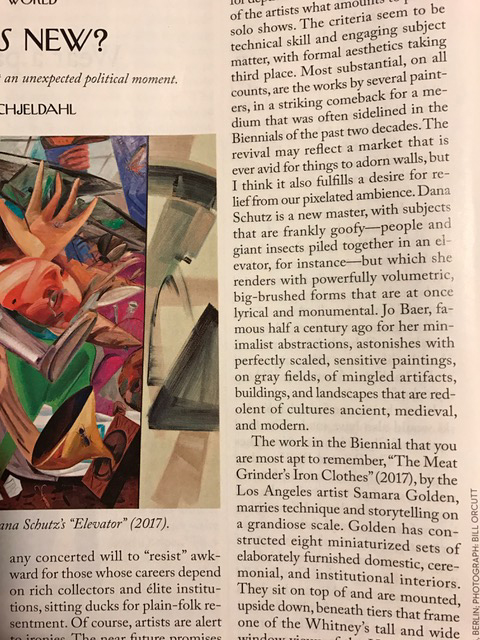
---
2015 the arts desk
Kent, Sarah, 'Jo Baer, Camden Arts Centre. The Minimalist who rejected abstraction for figurative painting. Or did she?', the arts desk, April 12, 2015. [online]
Jo Baer, Camden Arts Centre
The Minimalist who rejected abstraction for figurative painting. Or did she?
by Sarah Kent, Sunday, 12 April 2015
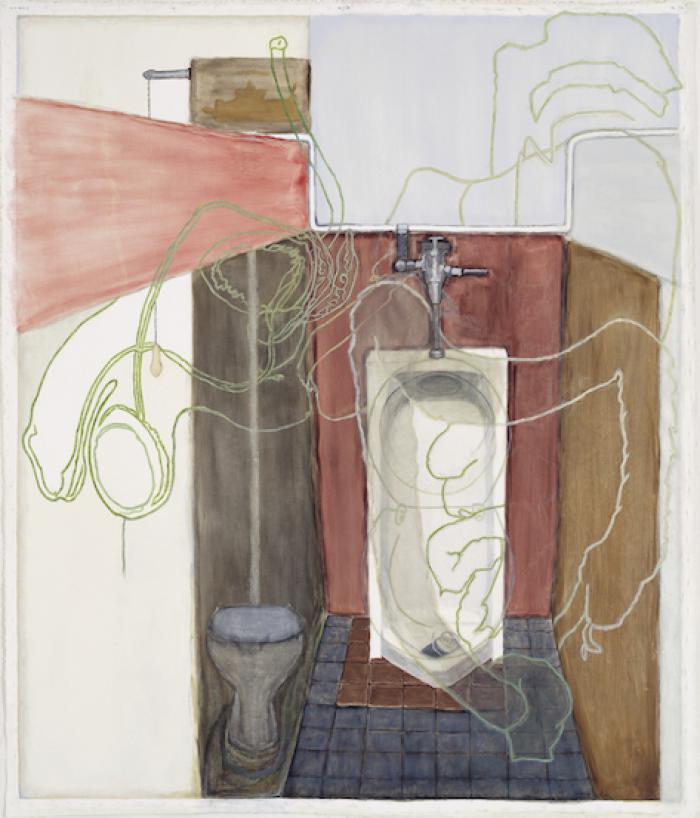
Shrine of the Piggies (The Pigs Hog it All and Defacate and Piss on Where From They Get It and With Whom They Will not Share. That s It), 2000. Courtesy Galerie Paul Andriesse.
At 86, Jo Baer is still painting vigorously. In the mid 1960s, she was an established New York Minimalist along with artists like Carl Andre and Sol Lewitt; but while they continued to explore abstraction, she changed tack – dramatically, or so it seemed. In the mid 1970s, she turned toward figuration declaring that the “naivety” of Minimalism (its refusal to engage with events in the real world) no longer made it relevant. Yet she still thinks of herself as an abstract painter and this survey, which spans 55 years, allows us to guage what she means by the claim.
In the early days, her attention focused on the edges of the paintings. Traditionally, this is the boundary between three-dimensional reality and the illusory realm of the canvas, but rather than windows onto an imaginary world, Baer’s abstract paintings function as objects in the here and now.
Four-inch thick stretchers turn them into slabs whose sides are as important as their front surfaces. Framing a blank centre, bands of restrained colour typically hug the edges and sides of what she dubbed “Wraparound” paintings. H. Arcuata, 1971, for instance, hangs horizontally on the wall like a radiator. Rather like the design on a Clarice Cliff teacup, a fin of black, green and terracotta stripes glides along the top edge before sliding down the front surface.
In 1975 Baer left the Big Apple, rented a 12th-century castle in Irelandand gradually left abstraction behind. The Old Year, 1975, is one of her first, tentative forays into figuration. Nothing could be more different from the hard-edged clarity and assertiveness of her Minimalist paintings than this enigmatic exploration. The thick stretcher is still a feature, but instead of emphasising the immediacy and physicality of the painting, it magically introduces a sense of time. Representing the moon, 13 blobs traverse misty overlays of orange and pale green to bounce across the canvas. The paint coalesces into three indistinct blocks of orange that seem to be moving across the surface, like clouds drifting across the sky.
...read more click here
---
2015 this is tomorrow
Warder, Alexandra, 'Jo Baer: Towards the Land of the Giants', this is tomorrow, June 8, 2015. [online]
Jo Baer: Towards the Land of the Giants
_by_jo_baer_-_courtesy_the_artist_and_galerie_barbara_thumm__large.jpg)
Artist: Jo Baer
Title: Heraldry (Posts and Spreads)
Website: www.camdenartscentre.org/
Credit: Courtesy the artist and Galerie Barbara Thumm
Jo Baer: Towards the Land of the Giants
CamdenArts Centre
10 April - 21 June 2015
Review by Alexandra Warder
‘In the Land of the Giants (Spirals and Stars)’, is the first painting you see as you enter Jo Baer’s exhibition at Camden Arts Centre. The work shows Baer’s interest in myth, folklore, history and story-telling. She compiles references together, joining them like stars in constellations, directing onlookers in various offshoots depending on which references shine brightest for each individual. In this first work, a Grecian discus thrower catapults Hurlstones into the dark vortex of a black pupil, an eye which looks out, and which is touched upon by the constellation of Orion the Hunter. He is the dominating force within the painting, and is placed above the image of Baer herself, as a self-referential reminder of the relationship between truth and fiction in her work.
Baer uses her imagination to draw upon real events and folklore. The representational object at the core of this is the Hurlstone. Baer discovered the object when she first moved toCountyLouthin the 1970s. When she asked why there was a perfect circle bored through the Hurlstone’s centre, she was told that legend had it that ‘a giant threw it there’. As with science-fiction literature, Baer imagines false narratives within her paintings and these become so tightly woven as to become a form of truth to her.
... to read more click here
---
2015 Hyperallergic
Ros, John, 'A Painter Who Left New York and Abstraction Behind, and Never Looked Back', Hyperallergic, June 2, 2015. [online]
A Painter Who Left New York and Abstraction Behind, and Never Looked Back
by John Ros
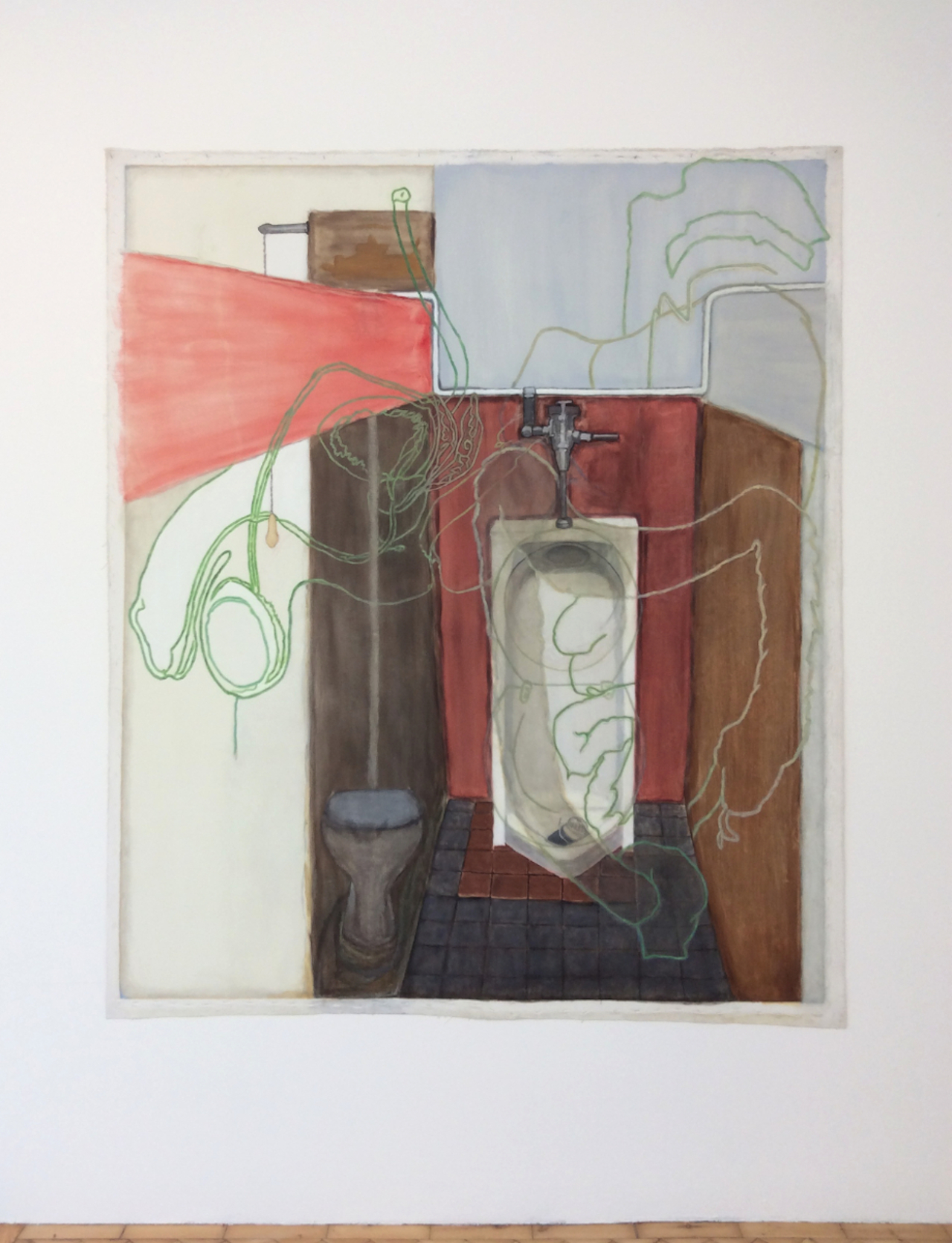
Jo Baer, “Shrine of the Piggies (The Pigs Hog it All and Defacate and Piss on Where From They Get It and With Whom They Will not Share. That s It)” (2000) (all photos by Valerie Bennett, all images courtesy Camden Arts Centre)
LONDON — Once an artist is written about, curated, collected, and fitted within a neat framework, there is this sense that the artist has somehow been “figured out.” We like categories, in part because they are easier to understand. The career of Josephine “Jo” Baer (b. 1929), however, has resisted this black-and-white way of thinking and compartmentalization.
Baer’s journey from the West Coast to New York City in 1960 brought her to great prominence. It was especially her intense and prolific research in so-called hardedge, non-objective painting that was applauded. As she furthered her practice, however, Baer could sense that her research in paint as a minimalist was shifting, as were her ideas of the modern art movement in general. Baer stated in a 1995 interview with Linda Boersma that the modern avant-garde art “died of old age”:
The world changed in the Sixties. We understood that revolution was no longer possible in 1968, that multi-nationals ran things, that Marxism as we had understood it did not work, that social justice was not imminent, that the optimism, which was the whole thrust of the twentieth century, was no longer current. The work in the Sixties was utopian. We already knew it was over and we were saying, ‘Yes, but…’ I think that was what characterized minimalist work.
With this sense that the times were changing, Baer moved to the countryside of County Louth, Ireland, in 1975. There, she opened and explored all possibilities. The country suited her, as she told me over the phone, and allowed her to reach new levels of research that nagging New York could never have allowed. Baer needed to get away from the suffocation of being a drone in the city’s art bubble. She, like many before her, became an ex-pat to experience the world, to explore differences among cultures and expand her curiosity in the studio. Not an easy decision for someone growing in fame, and sales, as she was at the time.
... to read more click here
---
2013 JO BAER AND THE MOLECULAR SUBLIME
Raskin, David, 'Jo Baer and the Molecular Sublime', in: Jo Baer. In the Land of the Giants, Stedelijk Museum Amsterdam, 2013, pp. 14 - 22 (cat.). [online]
JO BAER AND THE MOLECULAR SUBLIME
From Minimalist to Imagist. Science. Eschatology. Here is the alpha and the omega of Jo Baer, whose conituous project has spanned six decades (and countless millenia).For an exhibition at the Ludwig Museum, Cologne, in spring 2013, I suggested her earlier paintings produce shivers in the soul, as their pure sensuality invokes neurological responses beyond human control. Here, I shall argue that her final compositions disperse whatever might be left of our pride.
Famously, on the heels of her first great success, a one-woman exhibition at the Whitney Museum of American Art in 1975, Baer left New York for a castle in Ireland. Her new life was not quite a fairy tale, since the rambling stones had scant hot water and spotty electricity - though the neighboring children did think her a witch. But she was brave. She kept horses and painted pictures of their prehistoric ancestors, and over the next seven years filled her art with shapes of a different sort. Rahter than the spare geometry for which she had been celebrated, she began to practice what she termed "radical figuration," fragmenting familiar images in order to render them discomforing.
Baer had actually started the first of these new paintings while still in New York City, a transitional work entitled The Old Year, 1974-75 (fig. 1). She was searching for ways to engage a wider audience and had become fascinated by the photographs of Paleolithic cave paintings published in magazines like National Geographic and Scientific American. What struck her about these ancient marks was how each seemed to contain the entire cosmos. "This midway thing between abstraction and figuration," she said, "has always had a meaning, and you can find it. It's built in."

Jo Baer, The Old Year, 1974-75, installation photo, oil on canvas, 122 x 152.5 x 10.5 cm.
Collection of James Keith Brown and Eric Diefenbach.
...to read more click here
---
2013 Art Review Magazine
Myers, Terry R., 'Jo Baer', Museum Ludwig Cologne 24 May- 25 August ,
Art Review Magazine, December [online]
Jo Baer - Museum Ludwig, Cologne, 24 May – 25 August
By Terry R. Myers
This is an exceptionally sharp survey exhibition. Anchored by approximately 100 of Jo Baer’s works on paper from the early to mid-1960s (mainly small gouaches that were produced as possible prototypes for paintings), it succeeds in constructing a compelling argument against seeing her trajectory merely as split between an early minimalist phase and, from the mid-1970s, a figurative one. Brought together like never before (and in her first institutional show in Germany), the Amsterdam-based American artist’s works from various periods are given more than ample opportunity to re-present their connectedness despite their distinctions.
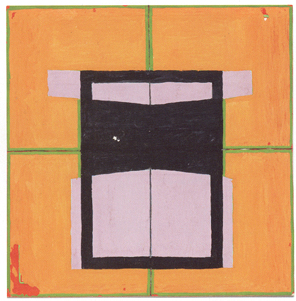
Untitled, 1960, Gouache on paper, 15x15 cm, Collection of the artist.
In some cases, the bond is straightforward. For example, in the midst of the small, predominately geometric gouaches, one in particular, Untitled (1960), contains a silhouetted and linear black image of a reclining female figure in the upper half of its white square, prefiguring (literally) the white shape of an ‘absent’ figure in a large linear painting called ’Tis Ill Pudling in the Cocatrice Den (La-Bas) constellation1(1987), and suggesting that the ‘radical figuration’ that Baer named for herself during the mid-1970s – at the point when she moved from New York to Ireland – began some time before, maybe even in the most geometric of the earliest gouaches and paintings that refer, in particular, to architectural detailing. Of course the titles of the two works mentioned above maintain a distance from each other, but that fact seems here to speak more of the different times in which each was produced than to the pictorial decisions Baer made in each instance.
Then again, this exhibition provides compelling evidence that Baer has made productive use of the gaps in verbal and pictorial language all along, by way of her clear and ongoing interest in signs and symbols – even within some of her specific series. I’ve had the privilege of seeing, in various places, several of her best-known ‘frame’ paintings from the late 1960s (white monochromes with black and/or coloured borders) as well as her idiosyncratic ‘radiator’ paintings from the early 1970s (so called because of their almost-on-the-floor wall placement and boxlike shapes), but never before have I focused as much on the connections between what they are and what they are capable of representing, not to mention how they are made. A radiator painting like V. Eutopicus (1973), titled after the Latin naming of plants, reinforces its organic ‘nature’ via the painted shapes that continue around its sides, similar to some of the earlier and more formal frame paintings that Baer has classified (rather than titled) as ‘Wraparounds’.
That initial bolstering is reiterated in the most recent paintings included here, especially Testament of the Powers That Be (Where Trees Turn to Sand, Residual Colours Stain the Lands) (2001), in which a mashup of natural and architectural imagery is framed by bands of colour along its vertical edges. With reinforcement upon reinforcement again and again, then, this exhibition provides a powerful type of mise en abyme for a deeper understanding of a deserving artist’s total endeavour by circumscribing it brilliantly.
---
2013 Frieze Magazine
Cahill, James, 'Jo Baer', Shows, Frieze Magazine , August 6 [online]
JO BAER|STEDELIJK MUSEUM, AMSTERDAM - NETHERLANDS
The title of Jo Baer’s current exhibition at the Stedelijk Museum, ‘In the Land of the Giants’, propels us out of the present into a mythic age when gods and men walked the earth together. Motifs are many and various throughout the show, which comprises a cycle of six new paintings and 18 drawings, but the predominant theme is a megalith in rural Ireland known as the Hurlstone, which acts as a hinge between human and superhuman worlds. Baer discovered the object when she first moved from New York to County Louth, on the eastern coast of Ireland, in the 1970s. A perfect circle has been bored through the Hurlstone’s centre: legend has it that ‘a giant threw it there’.
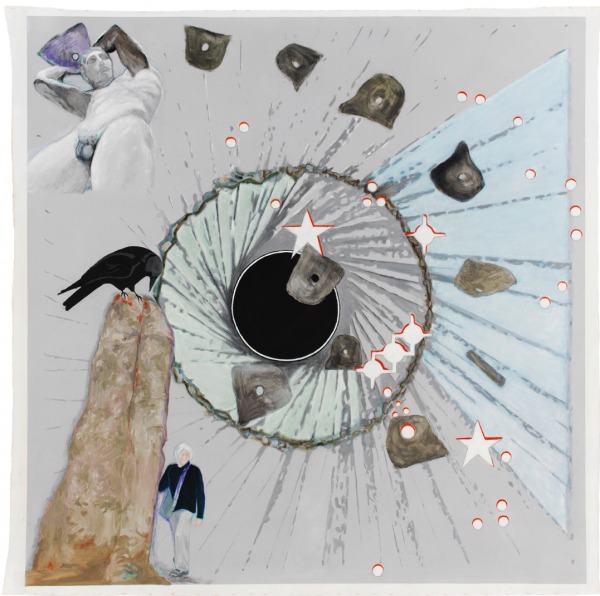
In the Land of the Giants (Spirals and Stars), 2012, oil on canvas, 1.5 x 1.5 m
This false aetiology indicates Baer’s fascination with the potential for mundane reality to become invested with preternatural import. Everywhere in this exhibition, naturalistic vignettes – the earthly stuff of stones, skulls or classical statuary – are irradiated by myth. Depicted in one corner of the painting In the Land of the Giants (Spirals and Stars) (2012) is a stone obelisk with Baer standing alongside, bag slung over her shoulder. Atop the stone is an oversize crow, while overhead a Greek discus thrower hurls a line of Hurlstones into a pictographic vortex based on the constellation of Orion the Hunter, an opaque black hole at its centre.
Baer repeatedly crunches together heterogeneous visual registers to produce a kind of spatial-temporal pile-up. The crow is simultaneously symbolic and literal, exuding the primordial starkness of Ted Hughes’s diabolical bird, ‘Nailing heaven and earth together’, while sliding just as easily into a present-day register. Elsewhere, the schematic mode of a map or diagram collides with its real life referent; or a picture-postcard scene is arbitrarily embedded like one of Patrick Caulfield’s photorealist ‘windows’. Such vignettes are hemmed in by neat lines and curves, becoming insets akin to illustrations in a school textbook. Handmade and digital modes similarly collide. In her drawings – small, extempore preludes to the paintings – crayon-jotted scenery jostles with photographic fragments. (Baer fed the imagery periodically into a computer and developed the composition on-screen); many incorporate physical scraps of collage.

Dusk (Bands and End Point), 2012, oil on canvas, 2.2 x 3.3 m
The ambiguity of these works is compounded by the way their disjointed dramas play out against monochrome grounds like so much pictorial flotsam and jetsam. In Dusk (Bands and End Point) (2012), the landscape is striking in its emptiness. The boundless idyll of the pastoral tradition has become uncharacteristically monochromatic – a line of flaming obelisks (observed in the Boyne valley, one of them apparently bearing a carving showing the earliest map of the moon) leads toward a field of grey nothingness. As in Auden’s ‘The Shield of Achilles’, where we might expect verdant imagery, we are confronted by nothing but ‘An artificial wilderness / And a sky like lead’. Bearing in mind Baer’s own trajectory from Minimalist painting to a kind of mythic figuration, it is tempting to read this particular image as a lurch back towards ‘pure’ minimal form (she wryly refers to her latest works as ‘abstract art with images’).
Indeed, the exhibition reminds us that wandering, whether between continents or representational modes, has been a defining aspect of Baer’s life. Over a career spanning seven decades, Baer has come a long way from her beginnings as a pioneer of Minimalism in the US in the 1960s. She made a decisive break from her roots in Minimal painting when she left New York for a Norman Castle in Ireland in 1975, adopting a style she termed ‘radical figuration’ (she eventually settled in Amsterdam where she has lived for the past 30 years).
In recent decades, Baer has consistently straddled personal and cosmic registers. In a diaristic catalogue entry, she refers to the ‘epic, colonial land-hopping’ in the early days of human society, which is ‘still marked by continental intrusions in the form of earth mounds, megaliths, and heavenly measurements systems.’ Such ancient systems, with their covert and ranging allusions, have an arcaneness that her latest works frequently share. In their promiscuous allusions, her compositions can appear as recondite as antique emblems or cryptic crossword clues. In Heraldry (Posts and Spreads)(2013), a coat of arms nestles within a larger tableau of skulls and rune stones. It furnishes an apt metaphor for the series in its entirety – compressed and encoded, dually figurative and symbolic.

Heraldry (Posts and Spreads), 2013, oil on canvas, 1.6 x 1.6 m
Clarity, where it occurs, is fleeting and deceptive, coming in the form of a glimpse of hillside and pathway, or a line of stones, or a cross-section of a medieval dwelling. But there is always a contrary, antithetical lurch towards what might be termed the fantastical. This can be subtle: we learn from the catalogue that two differently-shaped rocks possess a mythic animism, constituting ‘a tall male stone, a round (split) female rock’, while the rock Baer stands beside turns out to be that which held the dying hero Cúchulainn upright.
By contrast, in one of the drawings, we stumble across a cut-out of Goya’s Saturn, which hovers incongruously mid-page.In Royal Families (Curves, Points and Little Ones) (2013), an outcrop from one of Picasso’s reworkings of Velazquez’s Las Meninas has the appearance of a superimposed cipher. These seemingly random interpolations engender a general sense of the rational world invaded by irrationality. But ultimately, they point to the falseness of such an opposition. Why should a walk through ruins and rugged country not give way to thoughts of Saturn devouring his son, or the Infanta Margaret Theresa being administered to by her maid? The mind is picaresque in precisely this way.
Other art-historical oppositions (naturalistic versus schematic, figurative versus minimalist) similarly come to seem overly rigid in the face of Baer’s works. She rightly implies that the aesthetic of a map may condition or circumscribe one’s impression of the ‘real place’. Through their disarticulated form, her drawings deftly articulate the ways digital aesthetics are now shaping real-life perception. Hers is an art of liminality. (In the past, she has pointedly remarked: ‘This midway thing between abstraction and figuration has always had a meaning.’)
This show, which coincides with an overview of Baer’s paintings and drawings since the 1960s at the Ludwig Museum in Cologne, is a timely tribute to a long and protean career. Navigating her own past while answering a long call from antiquity, Baer also evokes the meandering and spurious course of mental wanderings or wonderings. Looking at her scattered compositions, we are reminded that this is how our perception works – through imaginative interpolation and unlikely associative leaps. Jolting between epochs in a fashion that calls to mind the melting-pot canvases of RB Kitaj, Baer’s compositions seem abrupt and arbitrary, but their disjunctions are less important than the connections we are coaxed into making.
What Baer sets forth is not exactly a Golden Age with gods and men joyously intermingling, yet transcendental and mundanely human spectres interlock throughout ‘In the Land of the Giants’. This comes to seem less an act of Promethean transgression than a straightforward reflection of the human brain, and the persistence and porosity of memory. In this, her work shares the simultaneous strangeness and familiarity of ancient mythology: discrete worlds collide, but are only a refraction of the jabber of different voices that condition our perceptions.
---
2013 The Brooklyn Rail
Rhodes, David, 'Jo Baer', ARTSEEN, The Brooklyn Rail , July 15 [online]
JO BAER|MUSEUM LUDWIG COLOGNE | MAY 25 – AUGUST 25, 2013
Jo Baer remains one of the foremost practitioners of Minimalism, having contributed to the movement many paintings and drawings, as well as writings that fueled the theoretical debates of the time. Baer’s famous letter to the editor ofArtforum in 1967, a rebuttal of Donald Judd and Robert Morris’s assertion in that publication that painting was inferior to sculpture, remains a key text from a seminal period when certain voices were a lot louder than others. This summer’s exhibition at the Museum Ludwig was originally conceived as a presentation of Baer’s minimalist works and was later expanded to cover the artist’s entire output, with an emphasis on early drawings. As a result, links and ruptures, continuities and turns in her creative path can now be traced and appreciated fully, as can the beauty and clarity of each individual work. Baer’s endeavor has always been concerned with painting––and not with fashions and movements––which has led to some historical misunderstanding of her work, righted here.

Jo Baer, “Cardinations,” 1974. Portfolio of 9 Silkscreenprints on handmade paper, 72 × 53 cm, edition: 75. Photo: Rheinisches Bildarchiv Köln. Courtesy of Museum Ludwig Cologne
The core of the exhibition comprises the museum’s 2010 acquisition of nine drawings from the early 1960s. A later portfolio of silkscreens, “Cardinations” (1974), was added to the collection shortly afterward and goes on view here for the first time. Also included are many beautiful gouache and graph paper drawings from the 1960s, alongside Baer’s later figurative paintings. The paintings, begun in Europe in the mid-1970s, display an abiding interest in the art of antiquity and prehistoric times that is evident even in the earlier drawings. What is at stake for Baer is the question of how to release or communicate ideas and perceptions through the medium of painting; within which category—the abstract or the representational, the minimal or symbolic—is not the issue.
At one point during the 1960s, Baer described her work as “pictures that picture their own shape,” thus aligning her paintings with the sculptural ethos of the time without needing to abandon painting itself. In Mel Bochner’s 1966 review of the major exhibition Systemic Painting at the Guggenheim, he remarked that, “The ambiguity of Jo Baer’s work is not created by its elements, but by its existence. Her paintings are not ‘about’ painting either as activity or thing…. [They are] an objectification of the nothing they contain.” Baer’s content is therefore very specific––and very far from the myriad painters today who claim that their work is “about painting,” as if that were something new.

Jo Baer, "Memorial for an Art World Body (Nevermore)," 2009. Oil on canvas, 183 - 153 cm. Photo: Rheinisches Bildarchiv, Cologne. Collection of the artist, courtesy Galerie Barbara ThummThe print portfolio “Cardinations,” published in 1974 by Brooke Alexander, reiterates and develops aspects of Baer’s longstanding interest in formal motifs that read as signs. Alert to the materials at hand and taking nothing for granted, here Baer responds to the inherent differences between an object (a painting) and a page (a print). The symbols inserted here in a circular array—1 to 9—are the cardinal numbers, precursors of Sanskrit numerals. Looking from one to the next in sequence, the “Cardinations” appear to turn and inscribe space, each connected to, but completely different from the others, like an idea being turned over in the mind. Six of the “Cardinations” hang on one wall, three on either side of the doorway to the next gallery; centered in this doorway on the far wall is the 6-foot-square oil “Untitled (White Star)” (1960-61). It’s a stunning juxtaposition, as the painting and the silkscreens evince both a subtle precision and a far-ranging openness to change.
 Jo Baer, “Untitled (White Star),” 1960-61. Oil on Canvas, 183 × 183 cm. Courtesy of Kröller-Müller Museum, Otterlo
Jo Baer, “Untitled (White Star),” 1960-61. Oil on Canvas, 183 × 183 cm. Courtesy of Kröller-Müller Museum, OtterloFrom the mid-1970s Baer pursued signs as vital images, referring to a concept of “radical figuration” to explain the new focus of her work. The narrow vertical “Facing (Towards/Away)” (1977), an oil painting using mostly earth colors, features fragments of a figure that could also be an ambiguous animal. It clearly references cave painting in its simple shading and gray/black partial outlines. Though such a turn toward figuration signaled a big change formally, Baer continued to look at shapes and ideas in search of something elemental—beyond reach and deeper in sophistication than whatever is, at any one moment, perceived as the most advanced strategy in art-making.
---
2013 NRC
Ter Borg, Lucette, 'Grande-dame' Jo Baer is nog altijd in gesprek met vroeger, NRC 19-03-2013
(English translation below)
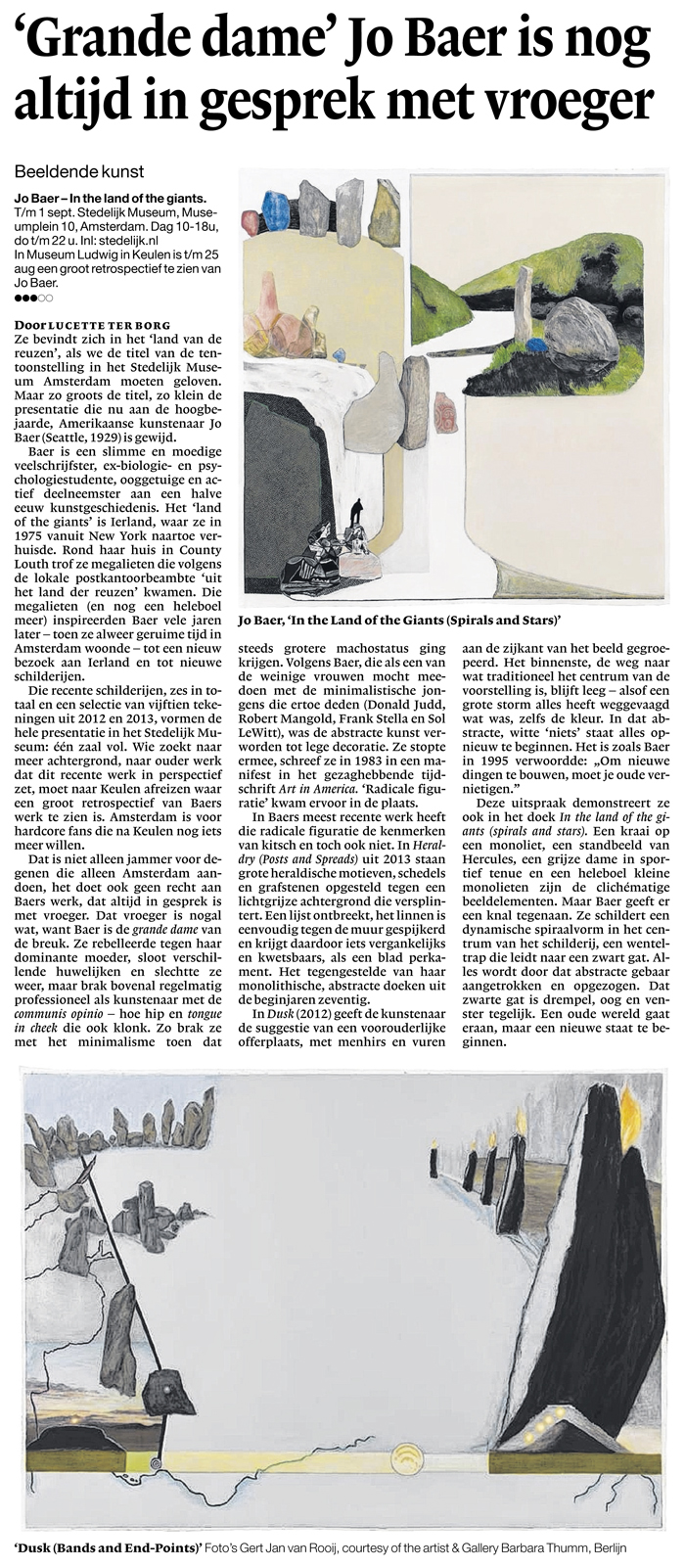
English translation:
‘Grande dame’ Jo Baer still in dialogue with the past
by Lucette ter Borg, NRC 19-03-2013
American artist Jo Baer (Seattle,1929) is in the ‘land of the giants’, if we are to believe the title of the exhibition in the Stedelijk Museum in Amsterdam. But the exhibition currently devoted to the now elderly Baer is as small as the implication of the title is large.
Baer is a clever and brave writer with an extensive oeuvre, an ex-biology and ex- psychology student, eye witness and active participant in a century and a half of art history. The ‘land of giants’ is Ireland, where she moved from New York in 1975. Around her home in County Louth, she found megaliths that, according to the local postmen, ‘came from the land of giants’. Those megaliths (and a lot of other things) would inspire Baer many years later, after living in Amsterdam for quite some time, to visit Ireland again and make new paintings.
These recent paintings, six in total, and a selection of fifteen drawings from 2012 and 2013, constitute the complete exhibition in the Stedelijk Museum. Those who are looking for older work to provide perspective will have to travel to Cologne, where an elaborate retrospective on Baer’s work is on display. Amsterdam’s exhibition is really for hardcore fans that were left wanting more in Cologne.
Not only is this a pity for those who only visit Amsterdam but it also does an injustice to Baer’s work, which is always in dialogue with the past. A past that is quite extensive as Baer is the grande dame of the rupture. She rebelled against her dominant mother and built several marriages only to break them down again, but above all, defied the communis opinio of a professional artist - no matter how hip and tongue in cheek it was. Baer broke with minimalism just when it was gaining more and more momentum for instance. According to Baer, who was one of the few women mentioned alongside the big names in the minimalist scene back then (Donald Judd, Robert Mangold, Frank Stella and Sol LeWitt), abstract art had become empty decoration. So she quit it and wrote a radical manifesto in 1983 in the prominent magazine Art in America, paving the way for ‘Radical figuration’.
In Baer’smost recent work this radical figuration is somehow both kitsch and not. In 2013’s Heraldry (Posts and Spreads), big heraldic motifs, skulls and gravestones are fragmented against a light grey background. The work lacks a frame and the linen is simply stapled to the wall, giving the work a temporary and vulnerable quality, not unlike a piece of parchment, and the opposite of the monolithic, abstract canvases she produced in the early seventies.
In Dusk (2012) the artist conjures up the image of an ancestral sacrifice with standing stones and fires placed on one side of the image. The interior, the traditional centre of the ceremony, remains empty - as if a big storm has swept everything away, even colour. In that abstract, white void everything can start anew. It is as Baer phrased it in 1995: “In order to build new things, you’ve got to destroy the old things.”
She visualises this statement in the canvas In the land of the giants (spirals and stars). A crow on a monolith, a statue of Hercules, a grey woman in a sport suit and a numerous little monoliths are the stereotypical elements in the work. But Baer gives it a punch. She paints a dynamic spiral at the centre of the painting, a winding stair leading to a black hole. Everything is attracted to, and sucked in by, that abstract gesture. The black hole is a barrier; simultaneously both eye and window. An old world may be crushed, but a new one is about to rise from the ashes.
---
2013 Artforum on line
Muller, Robert-Jan, 'Critics-Picks', Artforum.com [online]
---
2013 Artforum on line
O'Neill-Butler, Lauren, 'The Rijkstuff', Artforum.com /scene&herd 11.04.13 [online]
---
2010 Metropolis M
Verlaek, Jolien, 'Jo Baer - Broadsides & Belles Lettres', Metropolis M 22 Dec,
review in Dutch [online] review in English [online]
---
2007 New York Times
Holland Cotter, 'Art in Review: Jo Baer', New York Times, May 4, 2007 [online]
Jo Baer is best known for her immaculate early Minimalist paintings of white rectangles bordered with colored bands, and for a 1983 Art in America article titled ''I Am No Longer an Abstract Artist,'' in which she which declared that the realities of post-1960s power politics had rendered abstraction irrelevant. By that point she had moved to Europe where, in her 80s, she still lives. And she had started painting the figure, which she continues to do with verve on the evidence of the quietly vehement pictures at Gray.
A large, sketchlike oil painting from 1990 weaves together ballerinas, flamingos and a hanged man. Another from the following year sets dancers, mythical beasts and a giant pair of military boots in violent confrontation. Baseness is undiluted in a 2000 painting of toilet and urinal overlaid with the white-traced forms of intestines and male genitals.
In short, there's a lot going on in this work, with its allusions to history past and present, its references to visionary artists from William Blake to Jasper Johns, and its mood, at once lyrical and apocalyptic. We have more than our share of gallery exhibitions of painting right now. Ms. Baer's, offbeat, subtle and fierce, is one of the best. HOLLAND COTTER
---
2003 artcritical
Baron, Reuben M., 'Jo Baer: The Minimalist Years, 1960-1975', artcritical, June 1, 2003.
Jo Baer: The Minimalist Years, 1960-1975,
DIA, Chelsea
through Jun 15, 2003
Richard Serra's initial reaction upon seeing Jo Baer's orchid-inspired "Wraparound" painting, Baer has recalled, was to ask, "How does it feel to do revolutionary work?" [quoted in Stein, see below]. Moreover, the first important art-world article on Baer's work - a cover article by Carter Ratcliff in Art Forum (May, 1972) - focused on her wraparound painting, two vertical and three horizontal, from her Orchid series. So why did the predominant critical reaction to her recent DIA exhibition strongly favor Baer's earlier black band paintings over her wraparounds? Roberta Smith, in the New York Times, and Carol Diehl, in Art in America, both strongly praised the black band paintings while disparaging the wraparound paintings. (A notable exception was Jim Long's review in the Brooklyn Rail, (Winter 2002) which strongly preferred the wraparound paingings exhibited in the third room at DIA.)
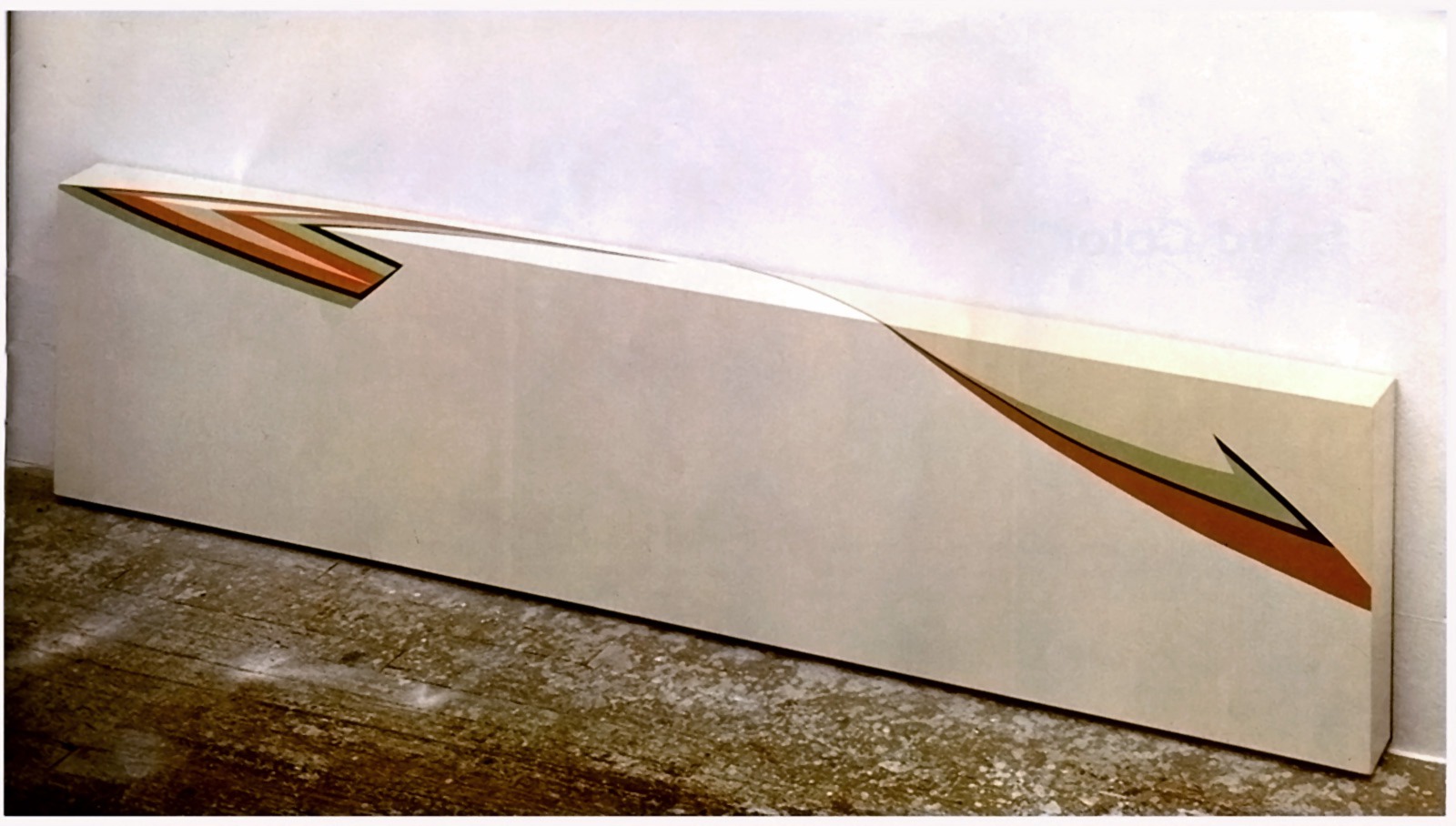
Jo Baer, H. Arcuata, 1971, oil on canvas, 56 x 244 x 10 cm.
...read more/download entire review, click here
---
2003 Artforum
Rich, Sarah K., 'Jo Baer', Artforum, NYC, Feb, pp. 133-134.
Viewed in reproduction, the early paintings of Jo Baer can make a misleading first impression. They might appear impassive, even “noncommittal,” to repeat a term used by John Ashbery when he reviewed Baer’s first solo show in 1966. Seen in person at Dia Center for the Arts’s current exhibition of Baer’s “Minimalist Years,” however, those paintings seem quite the opposite. They are grand, open, elegant things, and while these luminescent canvases are often pleasing to the eye, they are just as often satisfying to the intellect.
Dia showcases some of Baer’s most splendid efforts from the ’60s and ’70s, many of which address the instability of painting as a medium. Framing broad white rectangles of paint with dark bars of black outlines, for example, many of Baer’s seemingly blank tableaux enact the simultaneous acknowledgment and denial of the canvas (or any support) common to the normative appreciation of painting. In other words, with coats of white paint both referencing and covering the canvas proper, these works picture the (repressed) memory of the canvas that always haunts the medium.

Jo Baer, Graph-Paper Painting, 1962–63, oil on canvas, 36 x 36".
Other canvases explore even more blatantly physical properties of painting. Like her contemporaries Frank Stella and Donald Judd, Baer tested the distinction between painting as an object in the world and painting as a purely flat optical field. Crucial to Baer’s unique exploration of this distinction was a rigorous investigation of the frame and the stretcher. Her wraparound paintings of the late ’60s and early ’70s are known best for this investigation, wherein black bars (punctuated with thin stripes of color) creep around the sides of the works to appear on the z-axis of the stretcher, as well as on the x- and y-axes of the front.
Baer wasn’t the first to allow paint to make such a peripheral appearance, but her investigation exceeded by far the more haphazard marginalia of other painters of her generation. Walk up to just about any of Morris Louis’s “Unfurled” paintings from the ’60s and you’ll be able to follow rivulets of paint up the canvas-covered stretcher bar. That paint, however, had been poured to the edges of the canvas before it was stretched, and viewers reared on modernist discourses were supposed to consider those marginal colors inconsequential, if not accidental. Indeed, discourses of “opticality,” as developed by critic Clement Greenberg and his tributaries, demanded that such paintings be considered pure visual fields—otherwise they were in danger of stumbling into the three dimensions of sculpture. So the paint on the sides of many “optical” paintings was a sort of open secret. One often saw, but was asked not to acknowledge, the colors on the sides, because the true painting was to stop at the edges of the pictorial plane. It was in this context that Baer’s work confronted the instability of the frame. Her black bars (even as they helped to “picture” the whiteness of the canvas) called attention to the frame’s dual function as a pure cut between work and world, and as a bulkier thing that does the more muscular job of supporting the canvas.
Curator Lynne Cooke opens the exhibition with a room of works that, though predating the wraparound paintings, develop similarly clever approaches to the image/support dichotomy. A couple of large paintings from 1962 and 1963 that are based on graph-paper drawings, for example, are concerned with the support of drawing (rather than painting), although “based on” might be putting it too loosely. These are, in fact, exact renditions, reproducing both the geometric figures of the drawings exhibited nearbyand the graph paper on which those drawings appear—down to the slightly yellowed modulations on the paper. For the “support” of her drawings, Baer chose a green-lined graph paper that was punctuated with three groups of blue lines, like penmanship paper. On one sheet Baer drew a rectangle, the sides of which are two squares thick, over the grid. She then drew short black lines across the width of the long sides of the rectangle. It’s on those sides, with quiet precision, that Baer let the drawing converse with the graph paper support. The blue lines pass through the center of the rectangle with no effect. But in the lower portion of the rectangle, the blue lines seem to erase the short black ones. And in the upper region, the short black segments are further erased on either side of each of the blue lines. The composition of the drawing, in other words, yields to the interruptions of the blue lines on the paper. The subsequent painting is a portrait of that specific confrontation between support and drawn image.
Moving to the third gallery is like advancing to calculus after having taken a year of algebra, as some of the graphs and bars give way to softer curves in Baer’s so-called “orchid” paintings. Titled after plants Baer collects, the curving pastel motifs of these works seem to cling to and turn around the corners of canvases like the specimens for which they were named, prompting viewers to think of the image/support relationship as something like that of a parasite to its host. In the process, these paintings perform a sort of deconstructive violence on the very genre of “flower painting.” It is as if Baer took O’Keeffe’s pretty flower pictures and put them in a centrifuge, dispersing their forms out to the margins. Of course, there is a lot in these paintings for those who prefer not to crossbreed their abstraction with representation. The placement of some canvases horizontally and low on the wall encourages visitors to move up to and around them, thus allowing individuals to compare viewing habits common to sculpture (in which the viewer is often mobile) and painting (in which the viewer tends to remain in place).
It’s been several years since Baer’s early work received such careful attention in the United States. Indeed, given the dearth of scholarship on Baer, her work has been in danger of becoming as marginal as her signature motifs. The skillfully installed show at Dia, however, should help place Baer’s work (and keep it) front and center.
“Jo Baer: The Minimalist Years, 1960–1975” is on view through June 15.
Sarah K. Rich is assistant professor of art history at Pennsylvania State University.
---
Previously unpublished talk by and with Thomas McEvilley at Moore College of Art and Design, Philadelphia, on the occasion of the exhibition “Jo Baer: Recent Works,” March 3–April 1, 1993.
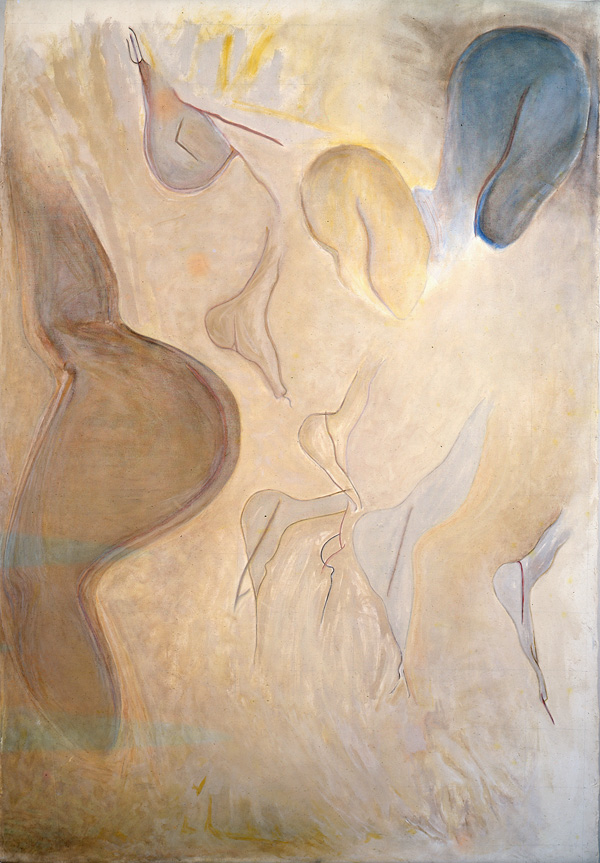
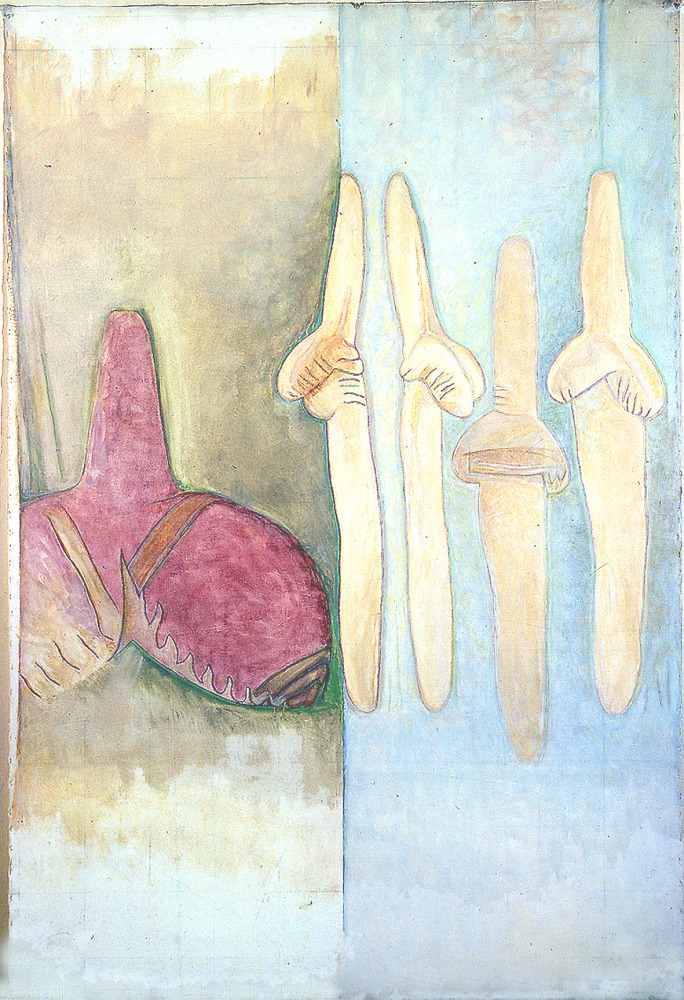

Thomas McEvilley: Recently, many things have changed about the way we view art and artists. One of the variables has to do with the traits that are expected in a career or oeuvre viewed in its broadest outline. Not long ago, an artist was expected to maintain a signature style more or less permanently. That was a part of the modernist ideology of art which assumed that artwork was based on aesthetic universals, or on the quest for them. In this view, if an artist were to change his or her style in mid-career, it meant either that the earlier work had not in fact been in contact with aesthetic universals, or if it had been, then the later work was not. An artist was, as it were, trapped in a style, or rather, trapped in a grip of the universals he or she had contacted. It was when Jackson Pollock changed his style in the early ‘50s that Clement Greenberg declared Pollock’s contact with the universals to have been broken. This was a part of the crypto-religious aspect of modernist aestheticism—an idea expressed long ago by Matthew Arnold about the aesthetics of his own time. In a sense, Post-Modernism consists simply in the exposure of the crypto-religious structure of Modernism, and in an attempt to genuinely secularize it. Nowadays, the saintly, religious aura that used to attach to the artist is seen as an embarrassment, as is the aura that once attached to the artwork as if it were a holy relic, and the deeply felt, personal style perceived as a sign of consecration, and so on.
To younger artists who were not raised in the Abstract Expressionist era, style has come to seem a kind of counter or abstract token that can be taken up and put down in any number of ways, but generally without the deep sense of commitment that Modernist artists were required to show to it. In fact to many Post-Modernist artists, the idea of demonstrating a deeply felt sense of commitment to a style would itself be an embarrassment. Much Post-Modernist art has existed precisely in a critique of the idea of style or its reduction to absurdity.
Jo Baer’s oeuvre confronts these issues most interestingly. A critic who contemplates her oeuvre as a whole is struck at once by its rather clear division into two stylist areas, which Baer refers to as the American work and the European work. The two phases are separated from one another in time as well as in space, with the American work preceding the European work. The show which Elsa Longhauser has put together here at the Goldie Paley Gallery is a major exhibition of the European work, which is generally less well known than the American work. In the ‘60s and early ‘70s, the American period, Baer participated, rather centrally in my opinion, in a truly critical moment of art history. When I first saw her work of this period I was living in Houston and starting research on the monochrome tendency in modern art. I remember my reaction when the Museum of Fine Arts there acquired a triptych of Baer’s white-edged canvases. Baer’s works had a simply stunning impact on me. I remember going back to the museum a number of times expressly to see them.
...read more/download entire talk, click here
...read the interview, click here
---
1975 Arts Magazine 49
Loring, John, 'Jo Baer', Arts Magazine 49 (April 1975) 8, p. 70

---
1971 Artforum
Linville, Kasha, 'Jo Baer at the School for Visual Arts', nr. 9 / May







_by_jo_baer_-_courtesy_the_artist_and_galerie_barbara_thumm__large.jpg)














